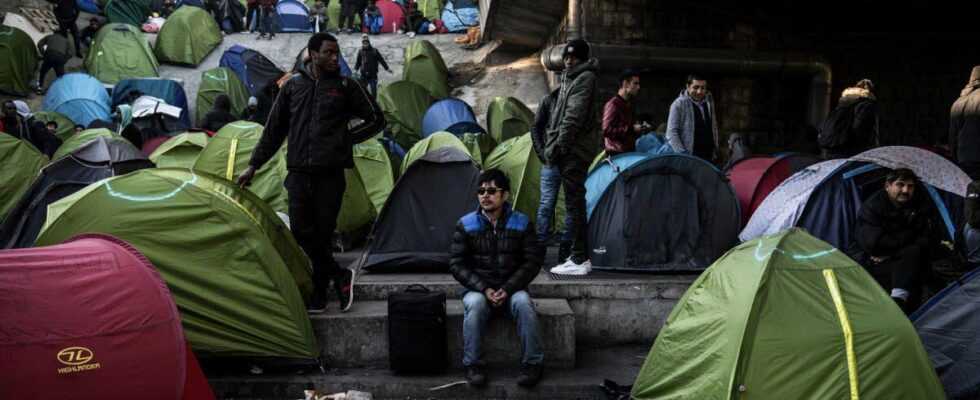Immigration figures for France in 2021 were released on Thursday. And, since then, the reactions on the right of the political spectrum have multiplied, castigating the five-year term of Emmanuel Macron. The deputy of the Alpes-Maritimes Eric Ciotti, unsuccessful candidate for the Republican primary, even speaks of “migratory chaos”.
“Emmanuel Macron’s migration policy in full debacle! “, outbids the candidate LR Valérie Pécresse.
The far-right candidate Eric Zemmour speaks, for his part, of “an explosion in the acquisition of nationality”.
We therefore wanted to decipher and contextualize five figures published Thursday by the Ministry of the Interior.
1/ Fewer asylum applications than in 2019
France recorded a significant number of first asylum applications in 2021: 104,577. That is an increase of 28% compared to 2020 (81,531 first applications). But the comparison is biased, the year 2020 having been strongly marked by the pandemic, the closing of borders and the freezing of many administrative procedures. Compared to 2019, the last reference year, the number of first requests is down 24% in 2021. Some 138,420 first requests were recorded at the time.
All cases combined (re-examinations, minors, Dublin procedures), the number of asylum applications is up by 30% in 2021 (121,554 compared to 93,264 in 2020). Figures, however, much lower than the pre-crisis level (151,283 in 2019).
It is also worth noting the explosion of asylum applications from Afghanistan, the leading applicant country with 16,126 applications. An increase of 62%, very marked especially after the evacuation operations of Kabul in August. The country has since been under the yoke of the Taliban, undermining human rights – especially of women.
The protection rate remains stable, however, at around 40%, while 60% of asylum seekers are rejected.
2/Residence permits: a stable level
With 271,675 residence permits issued in 2021 (+21.9% compared to 2020) excluding the British, the level almost reached that of 2019 (277,406 permits issued). These documents are mainly issued for family reasons (88,225), the majority of which are for spouses or parents of French nationals, or for student reasons (85,080). Economic immigration remains shy, despite the labor shortage: 36,560 residence permits were issued for this reason last year, less than in 2019 (39,131).
In addition, 96,632 residence permits were issued in 2021 to the British, compared to 22,451 in 2019 under the effect of Brexit.
3/Residence permit in France: a record?
At the end of 2021, 3.4 million foreigners had a right of residence in France. Their number is increasing steadily: they were just under 3 million in 2017. According to Eric Ciotti, France thus holds the record for the number of people with a residence permit, without however specifying the referent of comparison.
However, according to the latest European figures, Poland, Germany and the United Kingdom are those issuing the highest number of new residence permits. In 2018, one in five new residence permits issued in the EU were in Poland (635,000 permits issued). This was followed by Germany (544,000, or 17%), the United Kingdom (451,000, or 14%), France (265,000, or 8%), Spain (260,000, or also 8%), Italy (239,000, or 7%) and Sweden (125,000, or 4%).
The United Kingdom even estimates that nearly 3.5 million EU citizens live on its territory.
Brought back to the population of each Member State, the highest ratios of new residence permits issued in 2018 per inhabitant were recorded in Malta (35 new permits issued per thousand inhabitants), Cyprus (24), Poland (17) , Slovenia (14) and Luxembourg (13). According to 2021 figures, 4 new permits were issued in France for every thousand inhabitants.
4/Sharp increase in naturalisations, in particular due to Covid
With 94,092 new French people in 2021, acquisitions of nationality increased by 53% compared to 2020 (61,371). A figure also higher than in 2019 (76,710) and 2018 (77,778). The Ministry of the Interior justifies it by a catch-up effect, “the confinements having affected the chain of investigation of the files” in 2020.
But it is not the only reason. It was above all naturalization by decree that increased (75,249, +51.8% compared to 2019), a desire displayed by the government to facilitate the acquisition of nationality for foreign workers “in the front line” during the pandemic. But this is below the 115,000 foreigners who became French in 2010 under the Sarkozy presidency.
5/ Decrease in evictions
For evictions, on the other hand, the figures are down. All “removals” of foreigners in an irregular situation increased by 8.2% compared to 2020 (13,403 against 12,384), but remains very far from the level of 2019, with 23,746 cases. Strictly speaking, expulsions, called “forced removals” (+10%), were the driving force, in particular those of foreigners sent back outside Europe (+19.2%).
“As the police forces have further intensified their number of arrests, it is indeed the closing of borders, the refusal of Covid tests (compulsory to return to certain countries) and the refusal of consular passes by the countries of origin which complicate deportations,” the Interior Ministry told AFP. Last September, Paris had also announced the reduction in the number of visas granted to nationals of Morocco, Algeria and Tunisia because of the “refusal” of these countries to issue the consular passes necessary for the return of immigrants expelled from France.
All cases included (expulsions, assisted, spontaneous departures, etc.), 16,819 foreigners in an irregular situation left France last year (compared to 31,404 in 2019). Bad news for the government, criticized even before the crisis for its lack of effectiveness in its removal policy, while the number of illegal immigrants is estimated at between 300,000 and 400,000 in France.
